Carlisle to Haltwhistle, 26 miles. The tour company says there are “a few hills”. I’d call that two killer hills, c. 200m straight up.

But that’s getting ahead of myself. The day started with Carlisle Castle, a child’s storybook idea of a fortress, with its visible structure dating back to Norman times. (Although it goes back even further, for this is Roman Luguvalium, recently widely excavated for the construction of the new museum. And it was the promise of an exhibition from that excavation that made me decide to spend the morning at the castle. It didn’t disappoint.
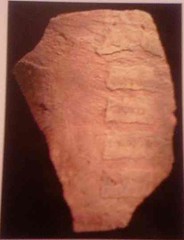 In the “stop press” section was a report on this unimpressive-looking sherd that in fact tells quite a tale. For miraculously surviving on these clay labels are the ink labels:
In the “stop press” section was a report on this unimpressive-looking sherd that in fact tells quite a tale. For miraculously surviving on these clay labels are the ink labels:
Fish relish
from Tangiers
old
excellent
quality
Missing are the labels indicating when it was made and the quantity it contained. It was found outside the commanding officer’s house from around 100AD, where it was probably thrown when empty. It would have been far too expensive for anyone else in the fort.
As often it is the rubbish and cesspits that provides some of the most interesting info: the inhabitants through the Roman era liked eating hazelnuts, although the luxuries of grapes and/or raisins and plums arrived in the second century. Coriander was a favourite food flavouring in the second century, but dill become more popular in the third.
But perhaps the piece de resistance is the finding of a Roman head louse, found on a wooden lice-comb that had obviously done its job. (And is shaped just like modern instruments that do the same job.)
There was also a fragment of a skull from late 12th or early 13th century, a youngish man killed by a blow to a head – this had probably been a severed head displayed above the castle gateway. It was found in the bottom of the ditch into which it had fallen. An ignominious end, then a very late “fame”.
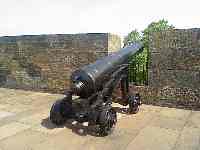
That’s a reminder that after the Roman left this was so often the site of conflict, and the fort’s business keeping the Scots in check – as perhaps it still is… (Much of the grounds of the castle – at least the newer bits, are still used by the military, and this scout car is housed within a 16th-century wall.)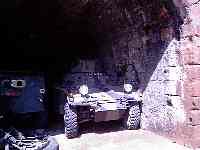
Then it was a mercifully flat run to Lanercost Priory, a beautiful, isolated spot, beside a river, and at the foot of one of those bloody great hills.
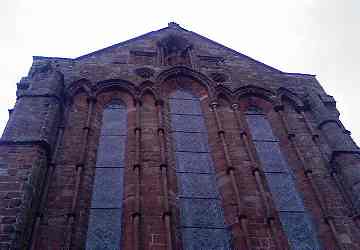 It contains within it the entire tale of the 12th to 17th century or so in this area: built by the Augustinians in the 12th century, raided by Robert Bruce in 1311 and home for more than five months to Edward I and his retinue in 1306-7, a stay that virtually bankrupted the place. It was only a shadow of its former self when Henry VIII closed it down, but the nave was kept as the village church, together with the statue of Mary Magdalene high above the entrance. (Guess its height was too much for the iconoclasts that would otherwise have wrecked it.)
It contains within it the entire tale of the 12th to 17th century or so in this area: built by the Augustinians in the 12th century, raided by Robert Bruce in 1311 and home for more than five months to Edward I and his retinue in 1306-7, a stay that virtually bankrupted the place. It was only a shadow of its former self when Henry VIII closed it down, but the nave was kept as the village church, together with the statue of Mary Magdalene high above the entrance. (Guess its height was too much for the iconoclasts that would otherwise have wrecked it.)
Parts of the rest of the complex was converted into a residence by the Dacre family, of the formidable Mary Neville fame, and the art historians are very excited about the recent rediscovery of some wall paintings from her era. They’ve been preserved in what is still rather nicely being used as a village hall – that’s what you call historical continuity. (In truth they are for the enthusiasts – you can just about see the griffin they talk about, but as for the rest of the subjects, well… I’m sure the experts are right.
Then, after that hill, the first proper fort of the wall, Birdoswald, which boasts an excellent, neat little museum that traces the “modern” history of the site, including its first antiquarian visitor Reginald Bainbrigg (presented in life-size model). He was a schoolmaster from nearby Appleby, who bravely visited in 1599, where William Camden was too afraid to venture for fear of the border reivers (raiders). Bainbrigg recorded it “doth seame to have bene some great towne by the great ruynes thereof. The inhabitants did shew me the plaice where the church stode, the inscriptions ther are either worn out by the tracte of tyme or by the clownishe and rude inhabitants defaced.” (This was probably the remains of the drill hall – today down to its foundations, a reminder of how late some much of these buildings stood – many for 1,600 years or more – until they were mined for stone as late as the 18th and 19th centuries.)
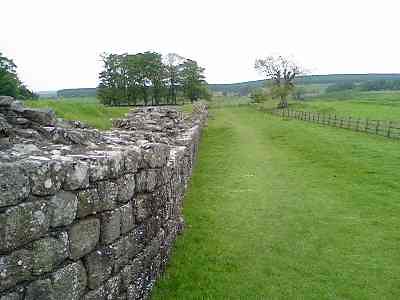 Still, enough remains of the walls to give a good idea of the layout of the fort, even though part of it is covered by a Victorian building that is today a youth hostel. (For groups only, unfortunately – would be a brilliantly evocative place to stay.)
Still, enough remains of the walls to give a good idea of the layout of the fort, even though part of it is covered by a Victorian building that is today a youth hostel. (For groups only, unfortunately – would be a brilliantly evocative place to stay.)
Finally, after the second killer hill, I staggered into Haltwhistle, and was happily revived by the first decent meal of the trip, at The Black Bull, a pub with real, proper, classy, food at a reasonable price. The locals tell me the landlords came from Ludlow way and brought a foodie culture with them; The Centre of Britain pub – yes Haltwhistle, among others, makes that claim – is also said to be very good.)

 About
About
One comment
Pingback: Symptoms of xanax use.